| Harms Park was a privately-owned picnic grove formerly located at the northeast corner of Western and Berteau Avenues. It became a park in 1893, lasting until 1946, when the land was re-developed for private housing. Henry Harms, the founder of Niles Center (now Skokie), originally bought the property in the 1850s. Born in 1832, Harms was a prolific character. In addition to founding Skokie, he was a farmer, building contractor, postmaster, legislator, constable, highway commissioner, drainage commissioner, and of course, a landowner. Notably, Harms was responsible for building Lincoln Avenue, as a plank toll road, from Morton Grove to Halsted Street. He found the time to father eleven children before dying in 1914, the year the image at right was taken.1 |  Skokie Historical Society Skokie Historical Society |
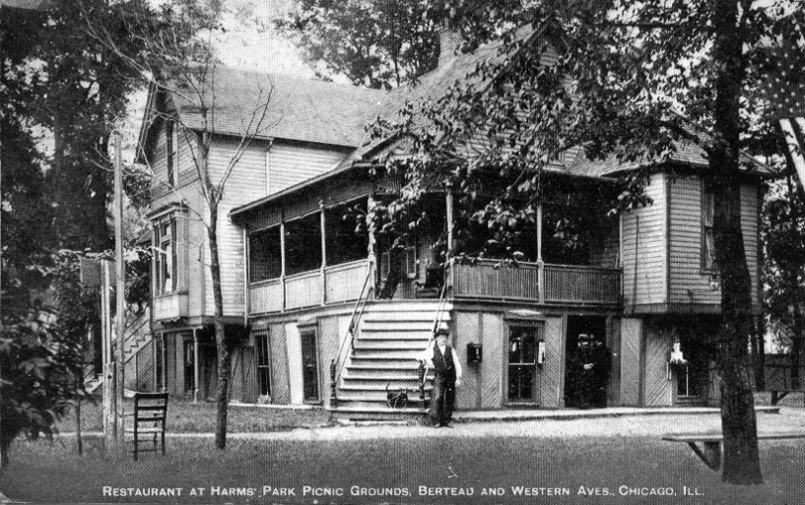 Chicago History in Postcards
Chicago History in Postcards
Harms’ Home, built in 1892. It was used as a restaurant by the time this postcard view was taken, presumably after Harms’ death in 1914.
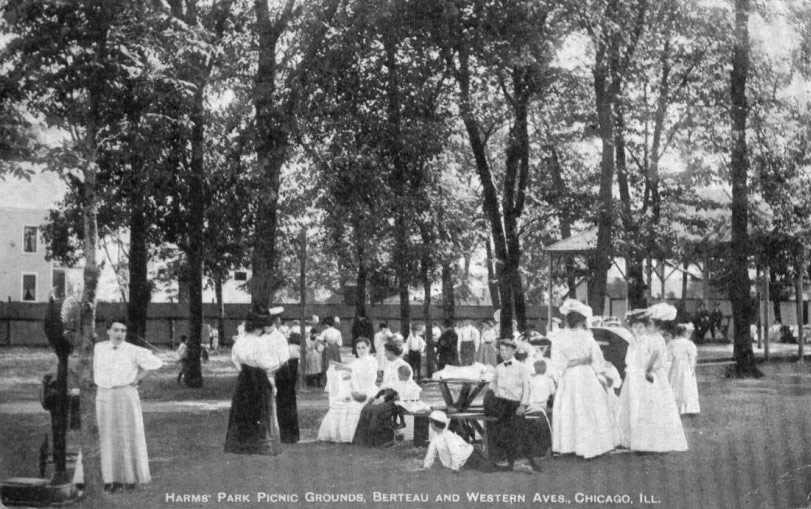 Chicago History in Postcards.
Chicago History in Postcards.
Many events and festivals were held in Harms Park, most notably the Chicago Old Settlers’ Picnic, which celebrated Chicago’s oldest citizens. 1937 marked Chicago’s hundreth year, and the Chicago Charter Jubilee held various celebrations and events, among them this picnic, which was held annually until 1946.2 The Charter Jubilee was also responsible for the placement of many historical plaques in various places throughout the city.
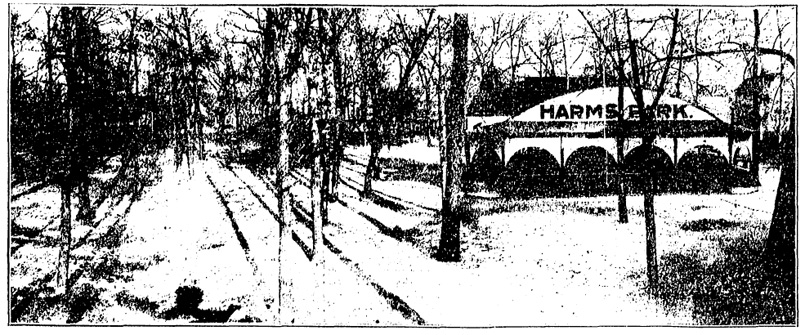 Chicago Tribune
Chicago Tribune
A Chicago Tribune article from November 2, 1933 brings up an interesting, and otherwise forgotten aspect of Harms Park; it was initially chosen as the site for the first PWA housing project in Chicago.
$1.3 million in Federal (PWA) funds were allocated, with an estimated total construction cost of $1.6 million. The project was to be built and operated by the Harms Park Housing Corporation, and designed by the architectural firm of Nimmons, Carr and Wright.3
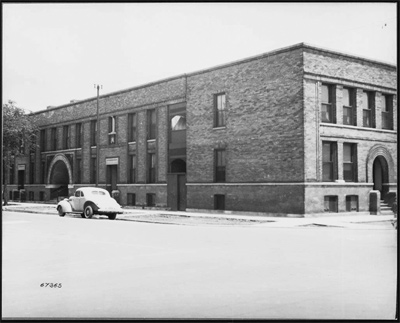
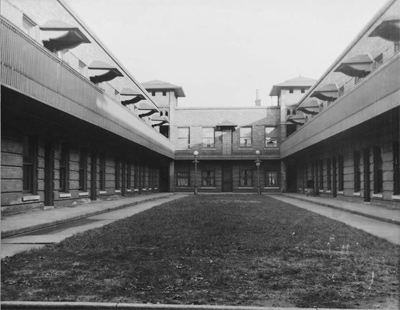 Gilman Lane, Ryerson-Burnham Historic Architecture and Landscape Image Collection.
Gilman Lane, Ryerson-Burnham Historic Architecture and Landscape Image Collection.
The plan consisted of 420 units in 4 buildings of 4 stories each. The buildings were to be built around courtyards, the largest being 200 feet long. Every room was to have a window, which was to be acheived by irregular room shapes. Although projected in the November 2nd article to be completed in 8 months, the subsequent outcry begins to explain why this controversial project never came to fruition.
A Tribune article from November 4, 1933 features criticism from Milo French, secretary of the First Englewood Bond and Mortgage Corporation. French claimed that existing units were unable to rent at $9.50 per room, the approximate price of equivalent privately-owned public housing, such as the Michigan Boulevard Garden Apartments, and that because of this, breaking even, let alone making a profit, was impossible. In fact, he sent a letter to Harold L. Ickes, the Public Works Administrator who had announced the project, stating that anybody who expected returns ‘must have had a shot in the arm.’4
In, 1933, the worst year of the Depression-induced housing crisis, only 21 apartment units were built in Chicago. French claimed that there were “enough apartments in Chicago.” It seems that this was a common criticism; a letter to the editor on November 12 by architect William Reichert also states that “there are too many apartments in Chicago now.”5 Both French and Reichert suggested modernization of previously constructed, privately owned units as an alternate use of the federal funds.
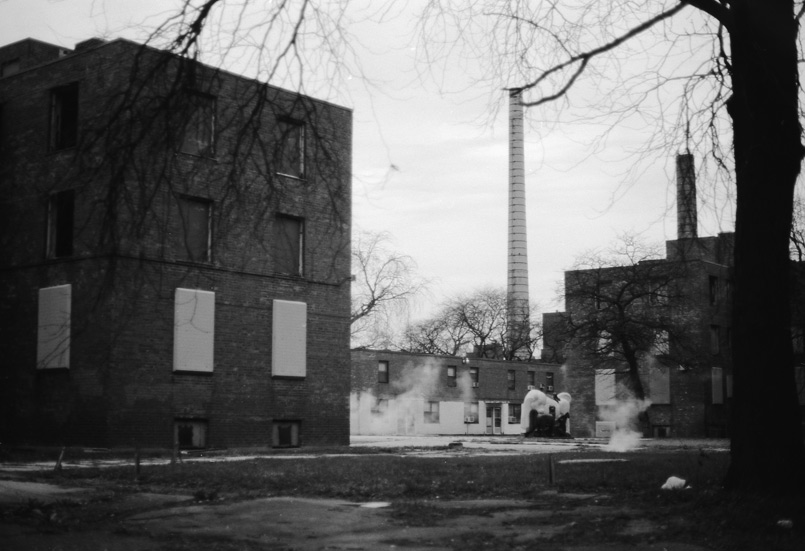
Area residents were also not fond of the project. 15,000 nearby residents against the project signed a petition that was “forwarded to Washington”. At the end of the day, it seems harder to find any supporters of the project. The last mention of the Harms Park Housing Project is in an article from November 24, 1933. The gist is that the backers couldn’t supply proof of a need for a ‘big housing venture’.6 A search of classified housing ads from these dates confirmed that apartments with the same amount of rooms in comparable neighborhoods were indeed renting for less.

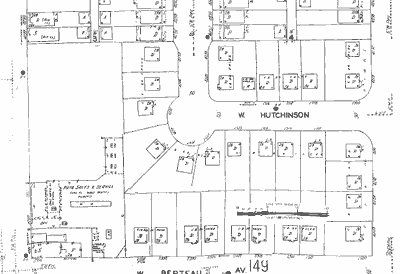 Sanborn Fire Insurance Maps, 1905 (left), 1950 (right).
Sanborn Fire Insurance Maps, 1905 (left), 1950 (right).
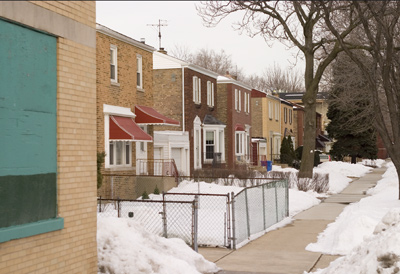
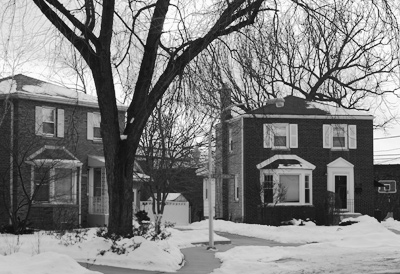
What did get built on the Harms Park site was the exact opposite of dense, Federally-funded public housing. Twenty-nine single family, detached, two-story-with-a-bay-window Colonial style houses, and an auto dealership were built instead. The lot sizes are much larger than surrounding lots, although the houses themselves have a rather modest footprint. Each house features a driveway, and the intersection of Hutchinson and Claremont was built with a faux cul-de-sac. This small development is more post-war, inner-ring suburban in character than the surrounding area.
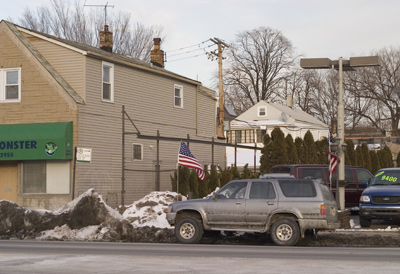

The portion of Harms Park closest to Western avenue was developed for commercial use. At some point in the 1920s, a store-and-flats drug store was built on this corner. The auto dealership was built surrounding the corner building, which has since been replaced.
In the left image, a clear delineation can be seen between the turn of the century frame houses and the former picnic grounds.
2“OLD SETTLERS TO REVIVE PAST AT PICNIC AUG. 2.” Chicago Daily Tribune (1872-1963), July 25, 1937, http://www.proquest.com.proxy.cc.uic.edu/ (accessed August 18, 2008).
3Al Chase. “Chicago Gets $1,333,000 For Housing Plan: U. S. Allocates Money to First Project Here.” Chicago Daily Tribune (1872-1963), November 2, 1933, http://www.proquest.com.proxy.cc.uic.edu/ (accessed August 12, 2008).
4Al Chase. “Housing Plan Draws Fire of Realty Field.” Chicago Daily Tribune (1872-1963), November 4, 1933, http://www.proquest.com.proxy.cc.uic.edu/ (accessed August 12, 2008).
5William Reichert. “Architect Raps Harms Park Housing Project.” Chicago Daily Tribune (1872-1963), November 12, 1933, http://www.proquest.com.proxy.cc.uic.edu/ (accessed August 12, 2008).
6Al Chase. “State Board Halts Housing Project Here.” Chicago Daily Tribune (1872-1963), November 24, 1933, http://www.proquest.com.proxy.cc.uic.edu/ (accessed August 12, 2008).
- South Western Avenue Improvement
- Wood Block Alleys
- Bertrand Goldberg in Tower Town Part 3: Bertrand Goldberg’s Michigan Avenue Project
- Chicago Motor Club Building
- Chicago’s Shoreline Motels – Central



